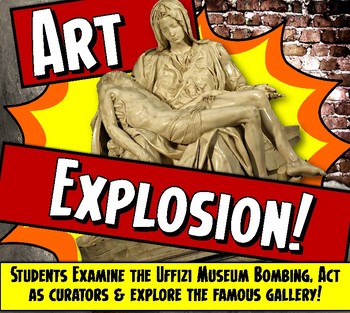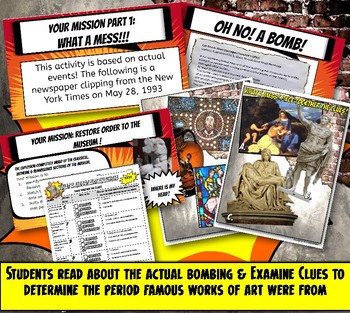Renaissance, Medieval, Classical Art Comparison Activity & Virtual Field Trip
- Google Drive™ folder

What educators are saying
Description
Oh No! The Uffizi Art Museum has been bombed! This activity is based on true events. You and your students will be pros at deciphering the difference between Classical, Medieval, and Renaissance art. Just like after the bombing, the artwork is disorganized, and students will use clues to determine which pieces go with which era (Classical, Medieval, or Renaissance).
Recently completely revised, this lesson is an incredibly versatile art investigation lesson set that will get students to compare art pieces in an updated, engaging format! It has 3 lesson options, with many combinations with interactive Google Slides, Google Docs or completely on paper!
Here's what's included:
1. A highly Interactive Google Slide Presentation that explains how to differentiate art between the Classical, Medieval, and Renaissance periods with all of the instructional steps included.
2. A New York Times Newspaper clipping that reports the bombing that took place on the Uffizi Museum in May 1993.
3. A "What A Mess" Graphic Organizer and Art Matching Examples Handouts- Students act as museum curators, determining which artwork belongs to which period. Essentially, students "re-organize" the artwork post-explosion.
4. A link to the Uffizi Gallery virtual museum.
5. A Tour of the Uffizi Gallery Graphic Organizer. Students use the graphic organizer to investigate and detail which era the artwork of their choice was from.
6. Answer Keys
7. A Google Docs Art Collector Lesson Option with example - Students make a chart of art he/she collected!
8. A paper-driven Art Matching Chart that students use to identify which era pre-selected pieces are from.
9. Teacher instructions for three different formats for differentiation!
† † † SAVE BIG!!! This activity is also included in the RENAISSANCE BUNDLE for great savings!
While this is an achievements-based lesson, all of our World History Curriculum, including Ancient History lessons and Medieval History lessons, are key-concept based, focussing on the “big six” key concepts for social science, often referred to as GRAPES. By learning World History with key concepts as a filter, students will become familiar with the crucial attributes that have allowed ancient and medieval civilizations to prosper. Also, students will build a framework, scaffolding future learning with the key concepts that will be repeated throughout their academic careers.
Each unit comes with notes, graphic organizers, and review worksheets that have the GRAPES key concepts in mind:
- G= Geography
- R= Religion
- A= Achievements
- P= Politics/Government/Leadership
- E= Economy
- S= Social Classes
⇒ Be sure to FOLLOW us on:
⭐ TPT to receive notifications of new products, sales, and notes to followers. Just click the “follow me” button next to the ⭐
✅Pinterest for creative classroom ideas, lessons, and more.
✅Instagram for laughs and to see products at use in the classroom.
✅Facebook for interesting articles, posts, & tips!
✅ Check out ourwebsite & blog</a>
❤️❤️❤️About Mr. and Mrs. P, the teachers behind Instructomania:
We are a Middle School teacher duo with over 40 years of experience in the Middle School classroom! We strive to create history and science lesson plans that inspire teachers and engage students, focusing on history activities for sixth, seventh and eighth grade. Our Ancient History and Medieval History curricula includes no prep worksheets and Common Core lessons that have been tested and polished in the classroom. World History activities are created with visually rich graphic organizer worksheets and fun thematic assignments. We hope you and your students love our products as much as we did making and using them in our Middle School classes!
➖➖➖➖➖➖➖➖➖➖➖➖➖➖➖➖➖➖➖➖➖➖➖➖➖➖➖➖➖➖➖
Terms of Use ☺
©Instructomania, Inc. All rights reserved by Tony and Erika Pavlovich. This product is to be used by the original downloader only. Additional teachers must purchase their own licenses. If you are a teacher, principal or district interested in purchasing several licenses, TPT now offers multiple license options.





